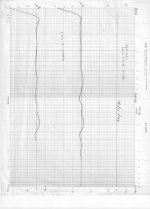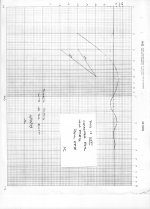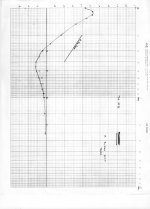Hi John,
My experience comes from repairing and aligning Revox, Studer and Tascam recorder - reproducers. Mostly at 15 ips, but some at 30 ips. Not very often for me of course. Norm from Studer Toronto would be the expert to consult. He did some training with me.
You're right about the issue being gap width of course. However, every head I know of is inductive and has a falling response with frequency, which is why it is common to resonate each head with some value of capacitance in order to flatten (and extend - even if it doesn't need it) the frequency response. I forgot to install the correct capacitors on a head change once and got **** for it. This was a religious talk show "star" who stood over me yapping my ear off. He also destroyed the motor bearings in the same machine by not allowing it to warm up before putting into service after my explicit instructions to do so. It was January in northern Canada and he had a long car ride (putting the machine in his truck after being told not to) and the temperature was well below zero fahrenheit. A loud idiot. Once they heard about everything I still was criticized for forgetting the head capacitors - something which I never had forgotten to do before or since. It didn't affect my relationship with Revox, but it really reinforced the need for proper value head resonating capacitors. I also had to change capacitors when modifying machines for different head types. Permalloy (glass) heads to Sendust (crystal alloy) had to be done experimentally. I to have some experience with this subject. I take it that Ampex didn't employ those capacitors then?
Best, Chris
My experience comes from repairing and aligning Revox, Studer and Tascam recorder - reproducers. Mostly at 15 ips, but some at 30 ips. Not very often for me of course. Norm from Studer Toronto would be the expert to consult. He did some training with me.
You're right about the issue being gap width of course. However, every head I know of is inductive and has a falling response with frequency, which is why it is common to resonate each head with some value of capacitance in order to flatten (and extend - even if it doesn't need it) the frequency response. I forgot to install the correct capacitors on a head change once and got **** for it. This was a religious talk show "star" who stood over me yapping my ear off. He also destroyed the motor bearings in the same machine by not allowing it to warm up before putting into service after my explicit instructions to do so. It was January in northern Canada and he had a long car ride (putting the machine in his truck after being told not to) and the temperature was well below zero fahrenheit. A loud idiot. Once they heard about everything I still was criticized for forgetting the head capacitors - something which I never had forgotten to do before or since. It didn't affect my relationship with Revox, but it really reinforced the need for proper value head resonating capacitors. I also had to change capacitors when modifying machines for different head types. Permalloy (glass) heads to Sendust (crystal alloy) had to be done experimentally. I to have some experience with this subject. I take it that Ampex didn't employ those capacitors then?
Best, Chris
Anatech, let's discuss this further:
There is a paper written by J. McKnight when he was at Ampex in the '60's regarding the 'optimum' capacitance, resistance combination for flattening the reproduce response for essentially lower speeds of analog tape, but there is more to the problem than initially meets the eye.
In 1968, I was assigned to test the reproduce head response with a new transformer and the standard heads at the time with the AG-440 analog tape recorder. What I found with a GR Q-Meter was that the the head-transformer combination had a Q of about 1 at 20KHz or so. Kind of low, wouldn't you think, so since I was also delegated to start on the next generation of electronics, I decided to find out why the Q was so low.
I found that the transformer-head combination, with its approximately 6mil lamination stack had very high eddy current losses that made the head-tranformer combination rise at 5 1/2 dB/octave, rather than the ideal 6 dB/octave, and that the resonance did help to partially make up for this loss. Of course, there was the scanning loss (almost nothing at 30ips) and the air space loss between the head and the tape that could be a factor, BUT it was the 6 mil laminations that did the bulk of the damage even in the upper midrange. Changing to 2mil laminations fixed the problem for the most part.
Now what is the origin of the I-V input, at least for me?
It so happens that Ampex had made a true master recorder from tubes in the early sixties that used I-V input called the MR-70, and it completely suppressed a rather low head-transformer resonance of 5KHz or less and yet had extended bandwidth at 15-30 ips. It was known to be a better tape recorder than the AG(Audio General)-440 and so I used its approach in my later solid state playback circuitry. It just so happens that the Studer A-80 VU MK 1 used I to V as well, but they changed it with the MK 2, for some reason. Still, 40KHz playback without head resonance is possible and practical at 30ips, as I have done it with 4 separate mastering recorders so far.
There is a paper written by J. McKnight when he was at Ampex in the '60's regarding the 'optimum' capacitance, resistance combination for flattening the reproduce response for essentially lower speeds of analog tape, but there is more to the problem than initially meets the eye.
In 1968, I was assigned to test the reproduce head response with a new transformer and the standard heads at the time with the AG-440 analog tape recorder. What I found with a GR Q-Meter was that the the head-transformer combination had a Q of about 1 at 20KHz or so. Kind of low, wouldn't you think, so since I was also delegated to start on the next generation of electronics, I decided to find out why the Q was so low.
I found that the transformer-head combination, with its approximately 6mil lamination stack had very high eddy current losses that made the head-tranformer combination rise at 5 1/2 dB/octave, rather than the ideal 6 dB/octave, and that the resonance did help to partially make up for this loss. Of course, there was the scanning loss (almost nothing at 30ips) and the air space loss between the head and the tape that could be a factor, BUT it was the 6 mil laminations that did the bulk of the damage even in the upper midrange. Changing to 2mil laminations fixed the problem for the most part.
Now what is the origin of the I-V input, at least for me?
It so happens that Ampex had made a true master recorder from tubes in the early sixties that used I-V input called the MR-70, and it completely suppressed a rather low head-transformer resonance of 5KHz or less and yet had extended bandwidth at 15-30 ips. It was known to be a better tape recorder than the AG(Audio General)-440 and so I used its approach in my later solid state playback circuitry. It just so happens that the Studer A-80 VU MK 1 used I to V as well, but they changed it with the MK 2, for some reason. Still, 40KHz playback without head resonance is possible and practical at 30ips, as I have done it with 4 separate mastering recorders so far.
...And, at 30ips, you introduce another problem, the resonance in the low frequencies that enters in an critical part of the spectrum. (~30 -> ~60 Hz ?)Still, 40KHz playback without head resonance is possible and practical at 30ips, as I have done it with 4 separate mastering recorders so far.
Then God, seeing his engineers so unhappy, with these bumps, this distortion, this hiss, these wow and flutter, these pre and post echoes ... decided to be lenient and offered us the digital. More than 10 time better in all domains.
Last edited:
You have my sympathy John! 🙂 You too can reach digital Nirvana, if you try hard enough!
Once the light goes on, and you no longer have to 'enjoy' this coloration, these bumps, this distortion, this hiss, this wow and flutter, these pre- and post echoes - its the music again!
Jan
Once the light goes on, and you no longer have to 'enjoy' this coloration, these bumps, this distortion, this hiss, this wow and flutter, these pre- and post echoes - its the music again!
Jan
Last edited:
That reminds me of the story of the student getting fed up with the obligatory stupid questions in the physics exams. <snip>
i heard that attributed to Nils Bohr.
That is the Military and Yahoo groups isn't it...Who is it that has the signature line "let's fix it until it's broken"? 🙂
It's a useful measure, but should not really be called dynamic range, which has a well defined existing meaning.
Of course; it is constantly creating misunderstandings, they should have denote it as something like "percepted dynamics/PD".
But anyway i was glad to find that paper describing the calculation, initially i was a bit surprised hat information about it was so sparse.
i heard that attributed to Nils Bohr.
Hmmm. I am sure I read it in one of my books, and I don't own any written by Niels Bohr. But it's possible. I like the story a lot.
Jan
If I am not wrong, Linn has a business line which is all analogue (turntables, etc.), and in parallel one totally digital (network players etc.).
A couple of years ago, I was invited to a private listening session of enthusiasts in the Netherlands.
On show was a multi-way loudspeaker system using digital crossover and correction filters.
The amps driving the individual chassis were just some cheap ebay LM3886 from China.
But I could not find any fault with the sound at all, except that maybe it was "too neutral".
At the end of the audition, there were some very rational and open technical discussions, without egos and emotions.
And I remember one of the statement was that digital crossover was great for development.
But once done, it would still be better to rebuild the crossover / filter in analogue.
"Analogue simply sounds better."
And that was from a gentleman building digital crossover himself.
Music, and hence audio, is subjective.
Wouldn't it be a less beautiful world if we only have MP3 and Class D chipamps from a smart phone ?
Maybe in 20 years time, that is precisely what we could be left with, like it or not.
So enjoy it while we can.
Life is too precious to be wasted biting at each other, just before the New Year.
Merry Christmas to all,
Patrick
A couple of years ago, I was invited to a private listening session of enthusiasts in the Netherlands.
On show was a multi-way loudspeaker system using digital crossover and correction filters.
The amps driving the individual chassis were just some cheap ebay LM3886 from China.
But I could not find any fault with the sound at all, except that maybe it was "too neutral".
At the end of the audition, there were some very rational and open technical discussions, without egos and emotions.
And I remember one of the statement was that digital crossover was great for development.
But once done, it would still be better to rebuild the crossover / filter in analogue.
"Analogue simply sounds better."
And that was from a gentleman building digital crossover himself.
Music, and hence audio, is subjective.
Wouldn't it be a less beautiful world if we only have MP3 and Class D chipamps from a smart phone ?
Maybe in 20 years time, that is precisely what we could be left with, like it or not.
So enjoy it while we can.
Life is too precious to be wasted biting at each other, just before the New Year.
Merry Christmas to all,
Patrick
Last edited:
Hi John,
Thanks for the information. I do know that Studer eq'd the head bumps out on their product line. Others, like Tascam, concentrated on 15 ips (wise choice for them) and just left the head bumps in place and didn't talk about them. Their machines sounded pretty good, but there is just something about a Studer that wins the day.
I have worked on an old Ampex machine, and some Scullys and helped on one MCI machine. Of all the tape machines I have seen, nothing was more gentle on the tape than the Studer products. For the money, Tascam had a very good product as long as it was properly set up (tape path needed shims everywhere). I'm not going to mention the Fostex or Tascam's answer to the Fostex machine (MRS-16 ? ).
Almost every machine I have ever worked with needed those capacitors to resonate with the head. With the Ampex having a "Q" of 1, that is on the border of too high. Would resonating it with a capacitor allow the response closer to 0.7 by chance? Was it a question of "close enough for rock 'n roll"?
I understand what was going on with those Ampec machines now.
-Chris
Thanks for the information. I do know that Studer eq'd the head bumps out on their product line. Others, like Tascam, concentrated on 15 ips (wise choice for them) and just left the head bumps in place and didn't talk about them. Their machines sounded pretty good, but there is just something about a Studer that wins the day.
I have worked on an old Ampex machine, and some Scullys and helped on one MCI machine. Of all the tape machines I have seen, nothing was more gentle on the tape than the Studer products. For the money, Tascam had a very good product as long as it was properly set up (tape path needed shims everywhere). I'm not going to mention the Fostex or Tascam's answer to the Fostex machine (MRS-16 ? ).
Almost every machine I have ever worked with needed those capacitors to resonate with the head. With the Ampex having a "Q" of 1, that is on the border of too high. Would resonating it with a capacitor allow the response closer to 0.7 by chance? Was it a question of "close enough for rock 'n roll"?
I understand what was going on with those Ampec machines now.
-Chris
{listening test in The Netherlands}
Life is too precious to be wasted biting at each other, just before the New Year.
Merry Christmas to all,
Patrick
I think I was there too ;-)
Agree with that Patrick. And to the criticism of my g/f I always answer: life is too short to waste time searching for matching socks 😀
Merry Xmas to all from here as well. May your days be full of beautiful music, however reproduced.
Jan
🙂
And I want to say that I am very thankful that John is still here with us.
As are Erno, Nelson, Scott, Jan, Bob, Joachim, ...... from whom I have learnt a great deal.
It took me many many years before I (finally think I) really understand the complementary JFET LTP.
Unfortunately we also lost a few in the last year or two.
Patrick
And I want to say that I am very thankful that John is still here with us.
As are Erno, Nelson, Scott, Jan, Bob, Joachim, ...... from whom I have learnt a great deal.
It took me many many years before I (finally think I) really understand the complementary JFET LTP.
Unfortunately we also lost a few in the last year or two.
Patrick
Jan,
The classic question: if you have ten white socks and ten black ones, in the dark how many do you have to take out to be sure you have a pair?
As a real engineer I buy all identical socks.
The classic question: if you have ten white socks and ten black ones, in the dark how many do you have to take out to be sure you have a pair?
As a real engineer I buy all identical socks.
Ampex ATR100 serie ?Of all the tape machines I have seen, nothing was more gentle on the tape than the Studer products.
- Status
- Not open for further replies.
- Home
- Member Areas
- The Lounge
- John Curl's Blowtorch preamplifier part II


